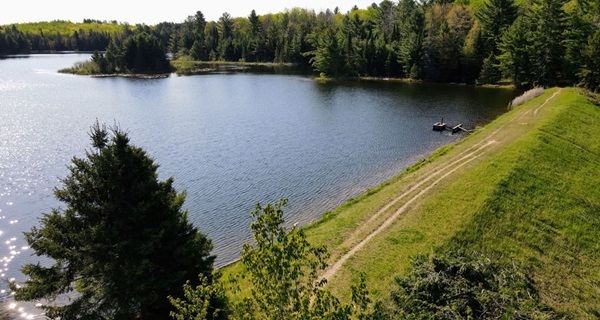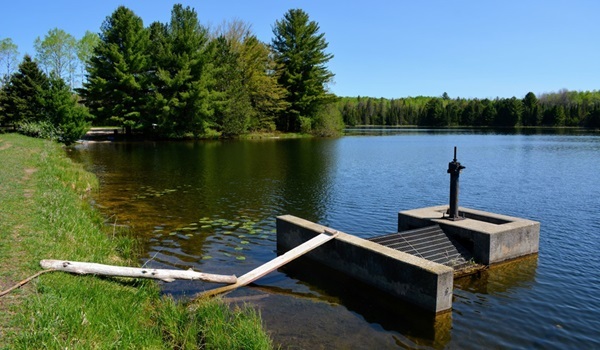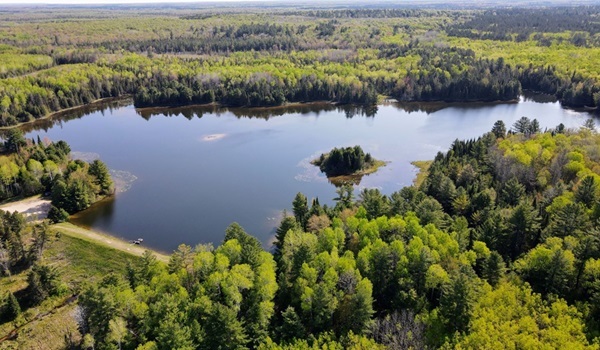 July 11, 2024
Contact: Josh Leisen, senior project manager, Huron Pines, 989-448-2293, ext. 16 or Tim Cwalinski, supervisor, DNR Fisheries Division, 231-340-0276
Cornwall Creek Flooding drawdown to begin Aug. 12
The 161-acre impoundment in the Pigeon River Country State Forest will be lowered by 6 feet to comply with a state safety order and prepare for the renovation of Cornwall Dam
Cheboygan County—Cornwall Creek Flooding will be lowered by approximately 6 feet beginning Monday, Aug. 12, to comply with a state safety order and prepare for dam renovations, with the goal of preserving the impoundment for recreation and wildlife. Access to the flooding will be affected, and the Shore-to-Shore equestrian trail will be rerouted during the project.
Northern Michigan-based conservation nonprofit Huron Pines is leading the two-phase project to draw down the 161-acre flooding and renovate the dam, which is owned by the Michigan Department of Natural Resources (DNR) Fisheries Division. Managed as a non-motorized fishing and recreation area, the flooding attracts anglers, kayakers and horseback riders and lies at the heart of the Pigeon River Country State Forest.
Built in 1966, the earthen dam impounds Cornwall Creek, a small tributary of the Pigeon River in southern Cheboygan County. A 2019 safety inspection by the Michigan Department of Environment, Great Lakes, and Energy (EGLE), the state agency which regulates dams, rated the dam and its water control infrastructure in poor condition. Past and recent engineering inspections indicate the partial drawdown is necessary to reduce the risk of a potential failure until problems with the dam can be addressed.
Huron Pines typically advocates for the removal of stream barriers including dams and undersized culverts. In its 50-year history, the organization has removed seven dams and led 150 road/stream crossing restoration projects across the northern Lower Peninsula. Josh Leisen is their Senior Project Manager heading this effort to renovate Cornwall Dam instead.
“In most cases we support the removal of man-made barriers from watersheds but we’re mindful of the added benefits of Cornwall Flooding for recreation and wildlife,” Leisen said. “We feel these outweigh the dam’s comparatively low negative impacts on Cornwall Creek and the Pigeon River, and we’re working to preserve the flooding so it can continue to serve its intended purpose as a place for quiet recreation and habitat.”
 Cornwall Dam is one of 62 such structures in Michigan that are owned by the DNR Fisheries Division, many of which are reaching the end of their projected life span. Because funds available for dam renovation are limited, Huron Pines brought together several stakeholders to raise the estimated $1.56 million needed to repair the dam and maintain the flooding.
Tim Cwalinski is the Fisheries Supervisor for the DNR’s Northern Lake Huron Management Unit and spent two decades as a fisheries biologist. Using data on visitor traffic at the public access site, Cwalinski estimated its impact on the local economy at over $100,000 annually in the form of convenience store stops, lodging, groceries, gear and other essentials.
“Cornwall Flooding is an economic engine for the region but those dollars go into the community, not to the DNR,” Cwalinski said. “When it came time to find the funds needed to repair the structure, having that quantified visitor data was important. Between the anglers, kayakers, campers, equestrians and other folks who use it, the department could justify restoring the dam. However, we need to come up with the funds necessary for renovation which is challenging.”
Curtis Goldsborough, a resident of nearby Wolverine, has been the public face of a supplemental fundraising campaign to support dam renovation. Through his outreach, video posts on social media and meetups he hosts at the dam, Goldsborough has built a community of supporters whose members share a personal stake in the project. More than 3,200 people have joined the “Save Cornwall Flooding” Facebook group he administers, where people post photos and stories of their experiences at the impoundment.
“My son and I love to winter camp and ice fish at the flooding, and paddling a kayak there at sunrise is an otherworldly experience,” Goldsborough said. “Families have generational memories and traditions centered around it. That connection to nature is important to a lot of people and it’s a big part of what motivates us all to make sure Cornwall Flooding is preserved.”
 DNR Fisheries Division Chief Randy Claramunt acknowledges the push to renovate the dam and maintain the flooding has come with its obstacles.
“Cornwall Dam is a poster child for addressing aging infrastructure while also recognizing the resource it provides,” Claramunt said. “There is no simple answer of just removing or repairing the dam; it involves understanding the tradeoff of costs versus public benefit. Engaging stakeholders in the decision has been critical in getting to this point, and Cornwall is a good example of working through that process. At the same time, EGLE has made it clear the drawdown is something we need to do to prevent a failure of the dam.”
For the drawdown, contractors will modify the dam’s existing water intake structure to gradually lower the flooding over the course of up to 90 days and at a rate of no more than 6 inches per day. This controlled, permitted and irreversible drawdown will allow time for exposed bottomlands to stabilize while minimizing sediment input into Cornwall Creek and the Pigeon River.
The DNR says a drawdown of 6 feet will reduce the amount of habitat available for fish and some mortality may be expected, particularly during the winter. Some water will remain in the impoundment which is 25 feet at its deepest.
Public access via Tin Bridge Road will remain open during the project but access to the water will become increasingly difficult or impossible as it recedes. Exposed soils will be very soft and may be dangerous to people attempting to reach the water. The Shore-to-Shore equestrian trail, which crosses over the dam, will be closed and a detour will be implemented.
The project’s planned second phase will see the construction of a new water intake structure, the permanent decommission of the existing structure and the return of the flooding to current levels. A new intake structure designed to meet EGLE dam-safety standards and earn the approval of the DNR’s Natural Rivers program has yet to be finalized. Once a plan is in place, EGLE permits for renovation will be sought. Renovation plans will need to be bid out to contractors, at which time project partners will know if current funding is sufficient to cover the cost of renovation.
Approximately $1.5 million has been secured for the project so far through a combination of grants, state allocation and an ongoing public fundraising campaign. For a full list of contributors or to donate to the project, visit huronpines.org/savecornwall. Regular updates throughout the course of the project will be shared on that webpage.
Huron Pines is a 501(c)(3) nonprofit organization established in 1973 to conserve and enhance Northern Michigan’s natural resources to ensure healthy water, protected places and vibrant communities. With offices in Gaylord and Alpena, Huron Pines strives to improve economic, environmental, educational and recreational opportunities throughout Northern Michigan. To learn more, visit huronpines.org.
Note to editors: Accompanying photos, all courtesy of Huron Pines, are available below for download. Caption information follows.
The water control structure at Cornwall Creek Flooding:
Cornwall Creek Flooding, a 161-acre impoundment in the Pigeon River Country State Forest popular for fishing, paddling, dispersed camping and wildlife viewing:
Aerial views of Cornwall Creek Flooding:
|